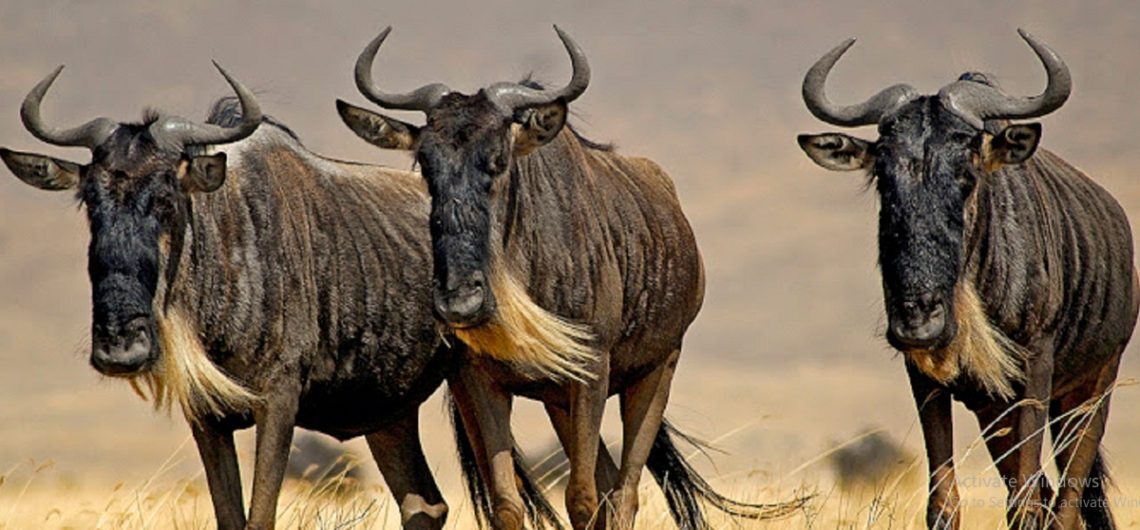Wildebeests of Kenya – The Wildebeest migration in East Africa
Wildebeests of Kenya: The wildebeest migration is an amazing annual occasion to watch that you wouldn’t want to leave out on your to do list in Africa. The event is recognized as one of the seven wonders of the Natural World, famously known to take place in East Africa, particularly in Kenya’s Masai Mara National Park and Tanzania’s Serengeti National Park.It is amazing how the wildebeests never lose their way to Masai Mara national park and also as they come back to Serengeti national park. Usually, wildebeest live in the Serengeti plains, where they spend majority of their lives grazing in the grassy savannas and open woodlands of the plains that divide Tanzania and Kenya.
The event happens annually where a population of over 1.5million wildebeest migrate from Tanzania to Kenya and vice versa following the seasonal rains, as they migrate they are accompanied by some other species of animals such as the zebras, Grant’s gazelle, Thompson’s gazelle, elands and impalas. . It is amazing how the wildebeests never lose their way to Masai Mara national park and also as they come back to Serengeti national park. The wildebeests face difficulties during their migration, including the risk of being devoured by lions on land and crocodiles when they cross rivers such as river Grumeti.
The wildebeest are believed to migrate for a couple of reasons such as looking for greener pastures of plains rich in nutritious grass to provide best conditions for raising their new calves and also to protect the newborn calves from predators like lions on the hunt for vulnerable newborns.
What time of the year do the wildebeest migrate?
The wildebeest migrate in different months of the year following the rain season and their birthing periods.
– Around January or February, the wildebeests are in the Ngorongoro Crater highlands and Olduvai Gorge giving birth to newborn calves which takes about 2-3weeks, the new born calves are very vulnerable and stand a risk of being eaten by predators on the hunt. It’s fascinating to observe the tension between the wildebeest and the predators at this time.
– In April, along with hundreds of zebra, the wildebeest trek northwest towards the center Serengeti in search of new pasture.
– In May, the wildebeest continue to roam the Serengeti, passing by camps that offer excellent vantage points to see them move, and at the end of May, the mating season starts.The wildebeest, zebra, and gazelle continue to graze while traveling at a leisurely pace. Here the journey is towards the GrumetiRiver.
– During June, the dry season starts with large concentrations of wildebeest in the Serengeti on the banks of Grumeti River, here the animals are faced with a challenge of crossing the river where they are prone to being eaten by crocodiles.
– In July, the wildebeests and zebras are headed for a more challenging situation of crossing the Mara River in the north of the Serengeti, however by the end of July the animals have successfully crossed the Mara River in Serengeti which stretches up to Masai Mara.
– By August, the herds have started spreading throughout the Masai Mara ‘s northern region with some still in Serengeti facing the challenge of crossing the river. Here the tension is high for the animals since the river is in full flow and there is great loss of life due to the hungry predators hunting after them.
– By September, the main chaos has ended but to be encountered again as the wildebeest head back to Serengeti.
– In October and November, the wildebeest head to Serengeti.
– By December, they are already spread in the South of Serengeti where they are lush rains.
How much does it cost to see wildebeest Migration?
This really depends in which part you are and in the camps you are residing in, however the park entrance fees are a bit expensive.
In Masai Mara, 70$ is charged per person per day.
THE WILDEBEEST MIGRATION, A WONDER TO REMEMBER!


Comments